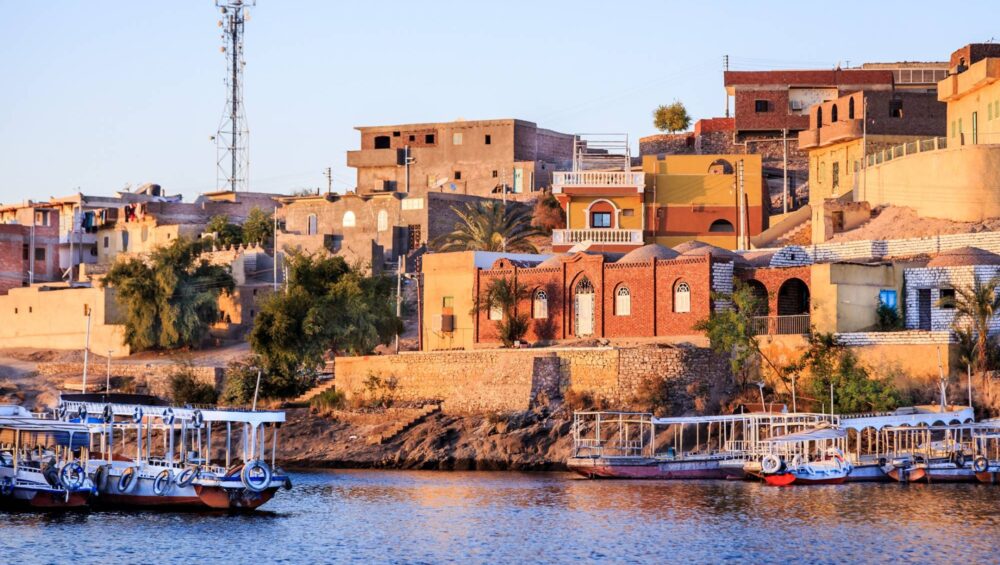Aswan, located along the banks of the Nile in southern Egypt, is a city of historical depth, cultural richness, and natural beauty. With its warm climate, serene atmosphere, and breathtaking landscapes, Aswan offers visitors a unique blend of relaxation and exploration. Known as the gateway to Nubia, this enchanting destination is a treasure trove of history and vibrant culture.
Historical Significance
In ancient Egypt, Aswan was called Swenett and served as the southern frontier, marking the boundary between Egypt and Nubia. Its strategic position made it a vital center for trade, linking Egypt with Africa through the Nile River. Aswan’s granite quarries were a cornerstone of ancient Egyptian architecture, providing the material for iconic monuments like the obelisks, temples, and even parts of the Great Pyramids.
The city’s role as a garrison town also highlights its importance in military campaigns and trade expeditions. This legacy of being a crossroads of cultures and commerce continues to shape Aswan’s identity today.
Discover the wonders of ancient Egypt with our exclusive Egypt travel packages.
Cultural Heritage
Aswan is renowned for its rich Nubian culture, which is distinct and colorful. The Nubians, known for their ancient civilization, have left an indelible mark on the city. Their brightly painted homes, traditional music, and unique cuisine create an immersive experience for visitors.
The Nubian Museum, located in Aswan, celebrates this culture with an impressive collection of artifacts, art, and exhibits that depict the life and history of Nubia. This museum serves as a bridge between the past and present, preserving a heritage that is both ancient and enduring.
Architectural Marvels
Aswan is home to some of Egypt’s most captivating architectural and historical sites:
- Philae Temple: This temple dedicated to the goddess Isis is a masterpiece of ancient Egyptian architecture. It was carefully relocated to Agilkia Island to save it from flooding caused by the construction of the Aswan High Dam.
- The Unfinished Obelisk: This massive obelisk offers a glimpse into the stone-carving techniques of the ancient Egyptians. If completed, it would have been the largest obelisk ever erected.
- Aswan High Dam: Built in the 1960s, this engineering marvel transformed Egypt’s economy by controlling the Nile’s flooding, providing irrigation, and generating hydroelectric power. Its creation also led to the formation of Lake Nasser, one of the largest artificial lakes in the world.
Discover the magic of Aswan with a tailored Aswan day tour, where you can explore iconic landmarks, sail the Nile, and immerse yourself in the vibrant culture of this historic city. Book your unforgettable adventure today!
Natural Beauty
Aswan’s setting is breathtaking. The Nile flows gently through golden deserts and lush green islands, creating a picturesque landscape. Visitors can enjoy a serene felucca ride, where traditional sailboats glide across the calm waters of the river.
Kitchener’s Island, also known as the Aswan Botanical Garden, is a verdant paradise filled with exotic plants and trees. It’s a perfect escape for nature enthusiasts seeking tranquility amidst the bustling city.
Elephantine Island, another gem, features ancient ruins and traditional Nubian villages, offering a blend of historical exploration and cultural immersion.
Top Attractions and Activities
- Abu Simbel Temples: Located a few hours from Aswan, these colossal temples of Ramses II are a UNESCO World Heritage site and a must-visit for history lovers.
- Nubian Villages: A visit to these villages allows you to experience authentic Nubian hospitality and explore their distinctive way of life.
- Felucca Rides: Sailing on the Nile during sunset provides an unforgettable experience with stunning views of the river and surrounding landscapes.
- Aswan Souk: The vibrant markets of Aswan are perfect for exploring local handicrafts, spices, and textiles, making it a haven for shoppers.
Relaxation and Leisure
Unlike Cairo or Luxor, Aswan has a relaxed and laid-back charm. The city’s smaller size and tranquil vibe make it ideal for leisurely exploration. Whether it’s sipping tea at a riverside café or strolling along the Corniche, visitors will find plenty of opportunities to unwind.
Modern Aswan
Despite its ancient roots, Aswan is a thriving modern city with excellent accommodations, restaurants, and infrastructure. The combination of ancient history and contemporary amenities ensures that visitors have a comfortable and enriching experience.
Why Visit Aswan?
Aswan is more than just a travel destination; it’s an experience that touches the heart and soul. Its rich history, welcoming culture, and stunning natural landscapes make it a must-visit for anyone exploring Egypt. Whether you’re a history enthusiast, a cultural explorer, or simply looking for a peaceful retreat, Aswan offers something special for everyone.
Plan your journey to Aswan, and prepare to be enchanted by the timeless beauty of this southern Egyptian gem.
Enhance your journey with unforgettable experiences! Explore our exclusive Nile cruises or choose from a variety of Egypt travel packages to uncover the wonders of ancient history and breathtaking landscapes. Start planning your dream adventure now!




